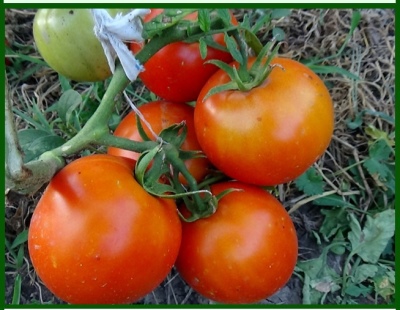
- Authors: Nastenko N.V., Kachainik V.G., Kandoba A.V., Agrofirma AELITA LLC
- Year of approval: 2008
- Category: grade
- Growth type: determinant
- Appointment: universal
- Ripening period: early
- Ripening time, days: 100-105
- Growing conditions: for open ground, for film greenhouses
- Transportability: Yes
- Bush size: undersized
Vegetable growers who live in cool climates are often limited in their choice of tomato varieties. Not every subspecies will tolerate frosts and temperature changes. But all this does not apply to the Snow Leopard. This variety with a beautiful name will definitely meet the expectations of summer residents from areas of risky farming.
Breeding history
The snow leopard was bred by Agrofirma AELITA LLC. It appeared thanks to the works of such specialists as Nastenko, Kachainik and Kandoba. It became widespread in 2008, at the same time it was entered in the State Register. It is proposed to grow the Snow Leopard both in open areas and in the conditions of film greenhouses. The variety takes root well in all regions of the country.
Description of the variety
The snow leopard is a classic and very unpretentious tomato variety. By the type of growth, it is determinant, the height of the bushes is in the range of 45-60 centimeters. Like many undersized varieties, it exhibits abundant foliage. The color of the foliage is dark green, and the leaf plates themselves are large in size.
The main qualities of the fruit
The plant forms large orange-red fruits. Unripe specimens are light green in color. Tomatoes have a standard flat-round shape, there is ribbing, but it is weak. The average weight of one berry is 120 grams, and the maximum weight is 300. The peel is glossy, smooth, with good density.
Taste characteristics
Tomato pulp Snow leopard has a medium density, moderate juiciness. Fleshy tomatoes taste sweet, aroma is very pronounced, rich. The purpose of the berries is universal. This means that you can cook any dish from them, including winter preservation.
Ripening and fruiting
The snow leopard belongs to the early group varieties, as it ripens only 100-105 days after planting.
Yield
Outdoor crops produce a stable yield of 2.3 kg per square meter. The readings will be higher under the film.
The timing of planting seedlings and planting in the ground
The seeds are sown 45-55 days before they are transferred to their permanent place of residence. Sowing is mainly carried out in the third decade of March. Before the procedure, the seeds are soaked in a growth stimulator for 12 hours. It is to be sown in nutritious fertile soil, which was previously moistened from a watering can or a spray bottle.
When the first shoots appear, the container with seedlings is placed in a well-lit area and the film is removed. Watering should be done in a timely manner. After picking, the plants are fed with a mineral mixture. Under the film shelter, the sprouts are taken out in mid-May. If cultivation is planned in the open air, then in early June.

Growing tomato seedlings is an extremely important process, because it largely depends on whether the gardener will be able to harvest at all. All aspects must be taken into account, from seedbed preparation to planting in the ground.
Landing scheme
The landing site is cleared and fertilized in advance. Dig holes, there should be 4-5 of them per square meter. Tomatoes are planted slightly at an angle, the soil must be well tamped.This is followed by watering - a liter of water for each plant. After that, the soil must be mulched so that the moisture remains longer.
Plants of the Snow Leopard variety are quite compact in their growth, therefore, a distance of no more than 50 centimeters can be left between the holes. The row spacing will be 40 cm.

Growing and care
The Snow Leopard will have to be looked after according to the classical scheme. This is timely correct watering, loosening the earth, mulching, or regular weeding, top dressing. It is important to note that dressings should be applied with caution and in no case exceed the dosage. This variety is prone to a quick set of foliage, and if he spends all his energy on its formation, then the fruit can never be expected.
An important point of care is the garter of the bushes. In greenhouses, the easiest way is to tie a tomato to a trellis, and if we are talking about open ground, then it is recommended to use separate pegs here.
The formation of bushes can be carried out in 1 or 2 stems. If the gardener decides to form a bush into one trunk, then he will need to remove all strong stepsons competing for the championship. When running a 2-stem plant, the stepson, which was formed under the first flower brush, is left to grow further.
As it grows, the plant will release more and more new shoots. They need to be broken off while they are small, otherwise the bushes will get stressed. The lower abundant foliage is also cut off so as not to thicken the planting.




A plant needs different micronutrients at each stage of growth. All fertilizers can be divided into two groups: mineral and organic. Folk remedies are often used: iodine, yeast, bird droppings, eggshells.
It is important to observe the rate and period of feeding. This also applies to folk remedies and organic fertilizers.
Disease and pest resistance
The snow leopard is very resistant to the tobacco mosaic virus; it is also not afraid of verticilliosis and fusarium wilting. Pests rarely appear in the beds. But in order to completely protect the plant, one should not forget about the cleanliness of the site and timely preventive treatments.


Resistant to adverse weather conditions
The snow leopard perfectly tolerates cold and sudden changes in temperature. He will not be afraid of the heat either. And also the variety is able to withstand short droughts.

























































































